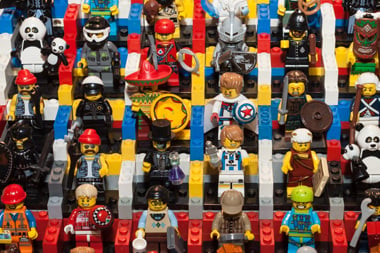How LEGO harnessed diversity to build an innovation culture
Friday 08 May 2015
Japanese premier Shinzo Abe’s criticism of innovative behaviour among firms in his own land has thrown a spotlight back on to how companies can best harness and exploit the creative spirit. In their recent book Brick by Brick, authors David C Robertson and Bill Breen explained how toy manufacturer Lego the company pulled itself back from the brink of bankruptcy to become the kind of brand that is to toys what Apple is to technology.
One of the firm’s key strategies was to plug into diversity in all its forms, to energise creativity and make innovation a more natural, organic process – a talent that the company would, in time, stake its reputation on.
Here are Lego’s core methods of putting diversity front and centre:
1. Diversity through hiring
During its revival, Lego has consistently stressed its desire to employ staff from diverse backgrounds as a means of developing greater innovation and creativity within its corporation. Currently, the company’s main focus is gender. The Danish toy manufacturer has a five-year plan to recruit more female workers to director level positions, or above. Lego argues that diversity can be a tremendous asset, as it brings together people with a rich cultural variety that contributes to a dynamic and competitive work environment.
2. Diversity in technical expertise
The toymaker also prides itself on working with specialists across different fields, who can each provide different approaches to R&D projects. One of the reasons the Lego brand remains strong today is because of its constant supply of new products. In order to keep them coming, the organisation ensures it has a diverse range of skillsets – ranging from programmers and marketers to product managers – to develop bigger and better ideas for Lego, such as digital games Portal Racers and Lego Fusion. Also a part of the process are so-called “master builders”, who are famous for making almost any object you could imagine out of Lego bricks. A George Washington head and a large aeroplane model hang in Lego’s Denmark headquarters.
3. Diversity in community engagement
Through the “Lego Ideas” crowdsourcing platform, the company has found a way to directly engage with customers and gain powerful insights into their demands. The open innovation platform allows Lego fans to submit their ideas for new toys, and if the concept gets 10,000 supporters in 365 days, it qualifies for official review by Lego marketers and designers. Following an appeal from seven-year-old Lego fan Charlotte Benjamin, who was disappointed that “there are more Lego boy people and barely any Lego girls”, geophysicist Ellen Kooijman came up with the idea for the "Research Institute" toy set. The kit included a miniature astronomer, chemist and palaeontologist, and was Lego’s first-ever set to feature female scientist figurines.
4. Diversity in customer relations
Last year, students at a Wisconsin elementary school studied 600 Lego kits to see what kinds of social messages they were sending out. Their research found that most Lego sets were marketed almost exclusively to boys and included very few female minifigures, while there was also a lack of cultural diversity – with just 27 of more than 400 sample minifigures representing non-European cultures.
The students’ efforts actually spurred a response from Lego executive Steve Clines, who promised that the company will be re-evaluating its product line. “It’s true we currently have more male than female minifigures in our assortment,” wrote. “We completely agree that we need to be careful about the roles our female figures play – we need to make sure they’re part of the action and have exciting adventures, and aren’t just waiting to be rescued.”
On the standard hue that minifigures are made in, Clines added: “We originally chose yellow for the colour of minifigures so they wouldn’t represent a specific ethnicity in sets when there were no characters represented. In this way, LEGO figures would be acceptable all over the world and fans could assign their own individual roles. However, in some products where we want figures to be as authentic as possible, such as movie characters, and others we plan in the future, some minifigures won’t be yellow to stay true to their characterisation.”
Judging by a key piece of recent research, Lego is working very much in the spirit of the times. According to the 2015 CEO Challenge report – produced in partnership with CMI – which surveyed more than 900 senior executives around the world, “CEOs see an inseparable link between customer-centricity, human capital and innovation, as well as the importance of diversity of thought on innovation teams and projects … [Also] CEOs appear more comfortable with pursuing open innovation concepts – recognition that connecting through formal and informal networks and alliances outside the corporate walls creates competitive advantage.”
Download the CEO Challenge infographic.
Image of Lego minifigures courtesy of Stefano Tinti / Shutterstock.
“We must embrace change if we want to improve”
Markus Lung, Chartered Manager of the Week, demonstrates how clearly sharing your vision will get people on board with a plan
Highlights – 26 March
The power of trust: in mentorship, music and the modern workplace
“I strive to connect on a personal level”: how Chartered Manager and software engineer Suzy supports her team
Suzy Masri CMgr MCMI shares how she fosters a supportive team environment and builds a sense of camaraderie
Accountability, purpose, client confidence and ethics: new insights for management consultants
What the latest issue of the Management Consulting Journal has in store
Case Study
We’re really proud of all of the managers, employers and training providers who choose to work with CMI, so here we’ve arranged a selection of their success stories.
Members See More
CMI Members have access to thousands of online learning and CPD resources. Learn more about our membership benefits
Join The Community
CMI offers a variety of flexible membership solutions, tailored to your needs. Find out more and get involved in the CMI community today.
